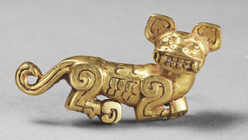On a recent Saturday, the Asian Art Museum in San Francisco was as packed as I’ve ever seen it. Out front, tour buses idled, unloading scores of pilgrims who had journeyed to Civic Center to see ten of China’s famous terracotta figures, the maximum number, we’re repeatedly told, the Chinese government allows to leave the country for display in a single exhibition. Inside, little children hugged the legs or clutched the hands of their parents, gaping at frozen archers, infantrymen, generals and their horses, while sullen teenagers, exercising their uncanny ability to be selectively exhausted, sprawled on gallery benches, faces down, wondering how much longer they’d be forced to endure all this boring fuss about some dead guy who thought he could achieve immortality by commissioning a 250,000 square foot burial site guarded by some 8,000 statues.
While the figures are the obvious stars of China’s Terracotta Warriors: The First Emperor’s Legacy, on view through May 27, 2013, the crowds appeared equally smitten by the 110 other objects on view in this handsomely designed exhibition.

Armored kneeling archer, 221 – 206 BCE
The first treasures are revealed in the Lee Gallery, where the roots of Emperor Qin Shihuang’s “Quest for Immortality” are explored. The first object we see is a bronze “Bo” bell made some time between 770 and 476 BCE, as much as half a millennia before Qin’s brief reign. Bells are related to the spirit world because it was thought the sound attracted one’s ancestors. As for the bell’s serpentine, decorative flanges, they were thought to amplify the instrument’s sound.

Iron sword with gold and turquoise hilt, 770 – 476 BCE
Another highlight of this lovely room is an iron sword, whose gold and turquoise hilt is a Tetris-like tangle of dragons. But the gallery’s show-stoppers are the life-sized pair of incredibly realistic bronze geese, who, along with a bronze swan and crane, appear to be making their way diagonally across the small, darkened space. Their naturalistic positioning in the gallery mimics the way in which they were discovered in 2001, almost three decades after the first terracotta figures were unearthed by farmers in 1974.




